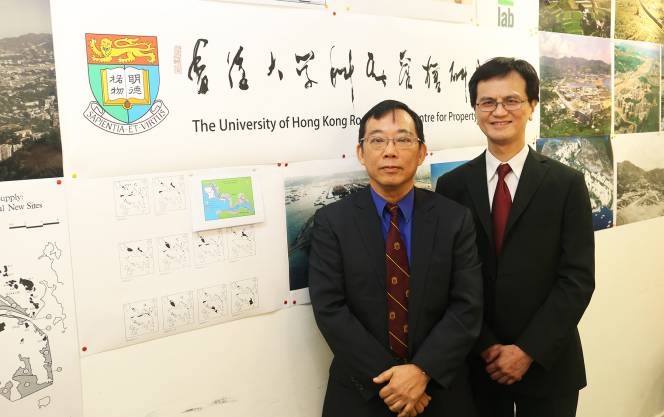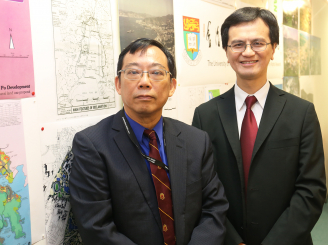Media
HKU Ronald Coase Centre for Property Rights Research releases Report
on the Long Term New Land Production Mechanisms and Strategies
26 Jul 2017
A research led by Chair Professor Chau Kwong-wing and Professor Lawrence Lai Wai-chung, Ronald Coase Centre for Property Rights Research, HKUrbanLab of the University of Hong Kong (HKU) on the history of new land production in Hong Kong has confirmed reclamation as the most significant and efficient historical mode of new land supply in Hong Kong.
Professor Chau is an expert in real estate economics and Professor Lai is an expert in urban planning who had work experience as a town planner in the Strategic Planning Unit of the Lands & Works Branch and an Environmental Protection Officer in the Environmental Protection Department.
They propose that the government should revamp a high-level standing mechanism to cater for the long-term production of land notably from large-scale reclamation. A decision-making body led by the Chief Executive should be set up to make strategic planning for a sustained stream of land supply and to make known its long-term planning options to the public on a regular basis1.
Apart from generating new land from reclamation, the government should also consider ways to speed up the conversion of suitable rural and peri-urban land into well planned urban settlements. A possible measure is for the government to reclaim the land titles of privately owned land left idle or vacant in the New Territories (NT) by announcing that their leases will not be automatically renewed upon their natural expiry in 20472 . Accompanied by a reform in the land premium calculation mechanism, the move will provide incentives to developers to use their land bank for housing and other uses. It will also allow the government to start planning early land use in the NT straddling 2047.
The current study by the research team has provided a timely review of the land produced by reclamation in Hong Kong from the 19th Century to 2015 and the institutional mechanism for strategic planning concerning reclamation from the mid-1880s to 2016. The last government study of such a comprehensive scale was completed and announced in 1989 in connection with the relocation of the Hong Kong International Airport to Chek Lap Kok, an artificial island formed by terracing the original island and extensive reclamation.
Research findings establish that reclamation is the most significant and efficient mode of new land supply in Hong Kong. According to published government sources, from 1950 to 2017, a total of 6,318 hectares of land in Hong Kong were produced by reclamation of the sea, accounting for about 30% of the usable land. The population increased by almost 5 million during the period.
|
|
Area of reclamation (Ha) |
Increase in population (million) |
|
1950-1969 |
1,044 |
1.741 |
|
1970-1989 |
2,729 |
1.610 |
|
1990-2009 |
2,545 |
1.171 |
|
2010-2017 |
Not available |
0.421 |
|
Overall |
6,318 |
4.943 |
Land supply was in particularly large amount during the economic takeoff in the 70’s and the sustained economic blooms in the 80’s and 90’s. Second generation new towns Shatin (including Ma On Shan) and Tuen Mun, which took shape in the early 1980s, have respectively about 630 ha and 500 ha of land from reclamation. The areas are mainly for public housing, private housing and industries. Later major development plans involving reclamations included:
|
|
Area of reclamation (Ha) |
Planning and development history |
|
Tung Chung New Town |
106 |
Planning announced in 1989 in tandem |
|
Tseung Kwan O New Town |
640 |
Planning commenced in 1977 but |
|
Hung Hum Bay |
45 |
Studies completed 1983, plan announced |
|
Aldrich Bay |
18 |
Studies completed 1983, plan announced |
The researchers are of the view that Hong Kong should regain its impetus and institutional means in land production by well-considered reclamation projects.
Professor Lai said: “The HKSAR government’s approach has left an impression that ‘new land supply’ is an ad-hoc response to immediate issues such as property price escalation rather than an ongoing commitment. The public has yet to hear any long-term policy for the future, say 20 to 30 years, production of land in possible locations.”
The 1997 Protection of the Harbour Ordinance has estopped major development plans including the reclamation at Green Island and Kowloon Bay (West), with the latest planned population at 135,800 persons on 176 ha reclaimed land and 285,000 persons on 300 ha reclaimed land respectively.
The research team proposes, for the sake of brainstorming, reclamation of the Plover Cove Reservoir site. The idea was considered a technically feasible option by an alumnus Mr Frederick Lai in an earlier research. The site covers an area of 1,200 ha and has the potential of providing a total supply of about 300,000 housing units (average size 650 sq. ft.). The damage to the environment will be less for the reservoir as the cost of damaging the original maritime environment was paid off when building the reservoir.
Professor Lai cites examples from Macau and Singapore which have been launching massive new reclamation projects as a long-term development policy. Singapore, for example, has made reclamation a national policy and almost 20 percent of its present land areas were from reclamation since independence.
Professor Chau Kwong-wing emphasises the importance of building a huge land bank by the government, for reducing price volatility and increasing living space per person to improve the quality of living.
He said: “Housing price volatility is partly a result of the pegged exchange rate system and partly the general perception that housing supply in Hong Kong cannot be easily increased in response to increased housing demand. As it is unwise to change the peg now, the only way to reduce housing price volatility and increase living space per person is for the government to plan for and build up a huge land bank for the foreseeable future so that land supply can become more responsive to housing demand and prospective property buyers are confident that the government can increase land supply when housing demand increases. This will reduce the chance of panic buying in the housing market.”
In view that major developers alone now own approximately 1,000 ha of land in the NT, Professor Chau considers it feasible for the government to announce to reclaim the land titles of idle or vacant land in 2047 to release land resources for housing development. However, the government also needs to change the current method of land premium calculation to incentivise developers to develop their land bank in the New Territories.
Please see attached the major findings of the study.
1 This is in response to the Commission on Strategic Development’s resolution on December 20, 2013 that “In the long run, Hong Kong needs a land production agency that is responsible for new land production and land conversion.”
2 Under Article 121 of the Basic Law giving effect to provision 2 of Annex III of the Sino British Joint Declaration. Constitutional authority of the HKSAR Government for grant of land leases beyond 30 June 2047, please refer to Lands Department’s paper: http://www.landsd.gov.hk/en/service/landpolicy.htm.
For media enquiries, please contact Ms Melanie Wan (Senior Manager (Media), Communications and Public Affairs Office) tel: 2859 2600 email: [email protected].


